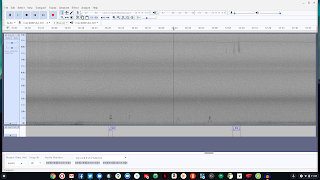Noc mig just got interesting with an Audiomoth (and a lot of experimenting!)
An enforced week off work isn't the end of the world in June, but I decided to limit my travels, and start a couple of projects. The moth trap(s) are going well, so in addition, I bought an Audiomoth.
Have known about Audiomoths for a couple of years now, but was put off due to the time needed previously to analyse results. However, these days time is not such an issue!
Fast forward a couple of days, and I am very pleased. The above screenshot shows Blackbird (#90) and a Soprano Pipistrelle (#91). Previous remote recording has always been either Birds with the Zoom recorder, or Bats with a Bat Detector. (Not sure if the Zoom was capable of picking up Bats?).
The ability to monitor both on the same wav file is pretty awesome.
Going thru the files this morning, I had the usual mix of our local birdsong, including goldcrest, which I haven't noticed for a while, then after dusk Common Pipistrelle, Soprano Pipistrelle, and Noctule, on a night when there didn't look to be much bat activity.
What you are not seeing is the two days of frustration experienced in getting to this point! My main PC is a chromebook, which has a superb battery life, fairly cheap, runs Android Apps, and Linux. But it can have shortcomings if you try to go beyond what it's capable of. My previous sound analysis workflow has always involved the linux app Wavesurfer. It soon became apparent this week, that Wavesurfer is no longer working on my linux container. Tried other Apps such as Kaleidoscope, but this too was not playing files. The only app I could reliably use was Audacity. Fortunately, Audacity has a lot going on in the background. I discovered that the Spectrogram is reasonable, and the "sound finder" algorithm has been a game changer, picking up both birds and bats on a single pass.
I also found a linux tool called Sox, which enables fast merging of wav files into a single file. All of which speeds up the process of sifting thru files for interesting calls.
My workflow is as follows:
*Run Audiomoth, collecting 4 minute files with 10 seconds sleep in between, (sample rate at least double what you are wanting to pick up, so over 200 for Bats)
*Copy files onto a Chromebook linux folder, and merge into 1 hour long files (command: sox <date>_20*.WAV Long20.wav, will collate all the files 20:00 to 20:59 GMT into a file called Long20.wav)
*Open the Long file in Audacity
*select all
*find sounds
*change view to spectrogram, and zoom out to over 100KHz if bats likely to be involved.
*tab thru calls
*for any bats, change speed for the selection to 1/10th in order to listen, and use spectrum analysis to determine frequency.
Quirks of Audiomoth, Chromebooks and Audacity, which made the project frustrating:
*Audiomoth, needs an app to set the time, and configure the device. There are windows and linux (and MAC) available, but the chromebook can't recognize the Audiomoth. The configuration had to be done on a nearby windows PC. As long as the Audiomoth doesn't run out of battery, and I don't wish to change the configuration, then I don't need to use the windows PC again. (A usb power bank connected to the Audiomoth when I change batteries should make this possible)
*Audiomoth works in GMT, this was confusing when setting up recording schedules
*When you turn the device on, it doesn't record until after a recording cycle has completed. So I have to wait 4 minutes to be happy it is turned on.
* recording failed initially, Am putting that down to a cheap SD card not keeping up with the file transfers.
*Audacity doesn't always recognise the correct sampling rate and files are played silently if it is wrong.
*When you download the config to the audiomoth, there is no acknowledgement that it was successful. You do get a config.txt file on the sd card, but this only appears after you turn the device to custom after flashing the config.
*The microphone is the tiny hole next to the white plate on the board.
*Audacity's default sound finder settings won't find anything! need to change the threshold from 2 to 30 for the fun to start.

Comments
Post a Comment